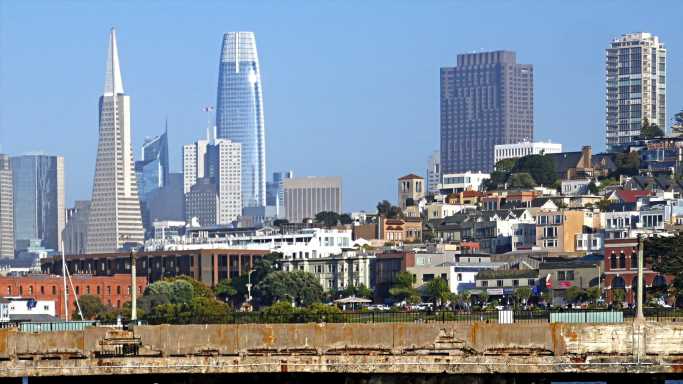The Worst Cities For Black Americans
The Civil Rights Act, signed into law by President Lyndon Johnson on July 2, 1964, made it illegal for employers and businesses to discriminate based on race, color, religion, or nationality. Though the articles outlined in the Civil Rights Act have been the law of the land for nearly 60 years, to this day, the legacy of centuries of state-sanctioned racism remains evident across the United States.
In the broad scope of American history, the South is associated with the most overt racial oppression. However, racist policies have shaped the economic and social structures across the country, including in Northeastern and Midwestern states. (Here is a look at the worst states for Black Americans.)
Policies such as redlining, which effectively excluded Black Americans from buying property in certain neighborhoods and school districts, were commonly employed in cities across the country. Not explicitly prohibited in the Civil Rights Act, housing discrimination was eventually outlawed under the Fair Housing Act of 1968. Still, access to housing and education can have a demonstrable impact on families for generations.
According to data from the U.S. Census Bureau’s 2021 American Community Survey, Black Americans are more than twice as likely to live below the poverty line as white Americans. Black households earn about 63 cents for every dollar earned by white households, the Black unemployment rate of 9.2% is double the white unemployment rate of 4.6%, and the Black homeownership rate of 47.7% is well below the 70.6% rate among the white population. As staggering as these disparities are, in many major metropolitan areas across the country, they are far worse than the national averages.
Using data – five-year averages – from the 2021 ACS, 24/7 Wall St. identified the 25 worst cities for Black Americans. To create this list, we used an index of eight variables measuring socioeconomic gaps between white and Black residents. Only the 225 U.S. metro areas where Black residents comprise at least 5% of the population were considered. It is important to note that this list does not rank the cities where Black Americans face the worst conditions, but rather the cities where the socioeconomic gaps between the white and Black populations are the largest.
Of the 25 metro areas on this list, 15 are in Midwestern states, and nine are in the Northeast. Only one of these cities is in the West and none are located in the South. Practices such as redlining were commonplace in many of these cities in the 20th century, laying the groundwork for ongoing inequality that remains evident today. (Here is a look at the worst voting districts for Black Americans.)
Click here to see the worst cities for black Americans.
To determine the worst cities for Black Americans, 24/7 Wall St. created an index of eight variables measuring racial socioeconomic gaps in each of the nation’s 384 metropolitan areas. For each city we evaluated the gap between white and Black residents in poverty, high school and college education, income, homeownership, unemployment, mortality, and incarceration.
Creating the index in this way means cities are ranked based on the relative differences between Black and white residents and not on absolute levels of socioeconomic development, which, if used for the ranking, would result in a list of cities with the worst social and economic measures for Black residents. Our aim, rather, was to rank cities where the differences between Black and white residents are most pronounced.
For each measure, we constructed an index of the gaps between Black and white Americans. The index was standardized using min-max normalization.
We excluded metro areas where Black residents comprise less than 5% of the population or where data limitations made comparisons between racial groups impossible.
Within the index, we considered data from the U.S. Census Bureau’s 2021 American Community Survey on median household income, poverty, adult high school and bachelor’s degree attainment, homeownership, and unemployment for each racial group. All ACS data are five-year estimates for 2021, the most recent year available.
Data on the number of prisoners in state or federal correctional facilities within a state by race are for 2020 and came from the Bureau of Justice Statistics. These figures were adjusted for population using ACS data. Because states, rather than metro areas, are responsible for the prison population, incarceration rates are for the state where the metro area is located. If a metro area spans more than one state, we used the state in which the metro area’s principal city is located.
We also included mortality rates for the years 2019 to 2021 from the Centers For Disease Control and Prevention. We aggregated mortality rates from the county to the metropolitan level using boundary definitions from the Census Bureau. Incarceration and mortality rates are per 100,000 residents.
Sponsored: Tips for Investing
A financial advisor can help you understand the advantages and disadvantages of investment properties. Finding a qualified financial advisor doesn’t have to be hard. SmartAsset’s free tool matches you with up to three financial advisors who serve your area, and you can interview your advisor matches at no cost to decide which one is right for you. If you’re ready to find an advisor who can help you achieve your financial goals, get started now.
Investing in real estate can diversify your portfolio. But expanding your horizons may add additional costs. If you’re an investor looking to minimize expenses, consider checking out online brokerages. They often offer low investment fees, helping you maximize your profit.
Source: Read Full Article



